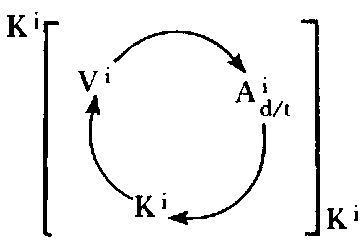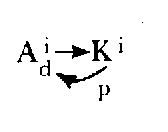3. AFTER "N" MANY STEPS, MAKE SURE ONE OF THE MODIFIERS IS EXTERNAL. This means that after so many steps in the strategy the individual should tune one of his/her representational systems to the external environment. This is to insure that the person or organization is getting feedback from their external context so they will be able to detect what effect the progression of the strategy is having and so they will not become caught up in their own internal experience. "N" will be determined by the kind of task being performed. If it is important to the carrying out of a task (such as basketball or therapy) that you gear your responses on the basis of actions taking place in your external environment, then put in an external check often. If the task requires more internal processing (like writing down an incident from memory or solving a complicated math problem) your external checks can take place less often. If you are not certain how many external checks are required for a task, a good rule of thumb is is, "When in doubt, put one in."
An alternative way of satisfying this requirement, especially in the context of tasks which require extensive internal processing, is the use of "counters." For example, suppose you are attempting to make a decision among several alternatives and your strategy involves a three point loop

for each alternative. Specifically, you look at each alternative (Vi), comment to yourself about it (Aid\t) and check to determine how you feel about it (Ki). Your strategy allows you to cycle around the loop to edit the pictures (Vi) based on the comments (Aid\t) and feelings (Ki) you have in response to them in order to arrive at the best visual representation of that particular alternative. The danger here is that you could become trapped in the editing and stay in the loop too long. This well–formedness condition is designed to protect against such an occurrence. The condition of including an external check would require interrupting the internal processing each cycle around the loop to determine, for example, how much time has passed. Equally effective and more natural would be the maneuver of introducing a counter on the loop. There are two easy ways of accomplishing this: (1) In the Vi step, you introduce a visual representation of a counter — that is, the first time through the numeral "1" is affixed visually to the starting image; each time the loop returns to that step (Vi) the visual counter is incremented by 1, so that consecutive cycles are visually noted 1, 2, 3 … etc. Using this approach, the decision maker would determine, prior to beginning the process, the number of edits to allow for each alternative. When that numeral appears, the strategy kicks in the next alternative and resets the visual counter back to 1. (2) Introduce a K which is outside the loop

The Ki is timed — that is, the decision maker determines prior to beginning the decision making how long to allow for constructing and editing each alternative. Ki is set for that length of time. When that time period (kept kinesthetically) has elapsed the Ki outside the loop switches the decision maker into the next alternative to be considered.
4. THERE SHOULD BE NO TWO POINT LOOPS IN THE STRATEGY. A two point loop is a loop in the strategy where the individual cycles or spirals between two representational systems, the usual result being that the loop doesn't exit. The loop is kept from exiting due to an inadequate test or because the operate phase (which only involves one representation system) is too minimal to make any significant change in the value of the representation being tested for. Loops that do not exit can be established in strings of representations that display more than two points, of course, and these should be avoided as well. But the majority of spiraling cases occur in loops of only two points because they do not generally access enough information or behavior to form an effective TOTE. An example of a two point loop would be if, during some strategy, an individual triggers an internal voice that criticizes him in a high pitched, blaming tonality. The blaming voice, in turn, triggers negative visceral feelings. The voice then blames the individual for feeling bad, and this causes the person to feel even worse. The voice then becomes further agitated and blaming, and the loop spirals between auditory and kinesthetic:
The same sort of interaction can happen among people in a family, group or organization as well. Notice that a change in any of the modifiers in a particular representational step qualifies as a new distinction. A change from auditory internal (Ai) to auditory external (Ae) would have kept this sequence from becoming a two point loop. A change from tonal to digital, from remembered to constructed or from a polarity response to a meta response would each qualify as a legitimate difference in representational quality.
As an illustration of these four well–formedness conditions, consider the following example of a decision making strategy which violates all of the well–formedness conditions. One of the authors was working with a woman who was experiencing a great many unnecessary problems in her life because of her inability to make decisions. The author elicited her decision making strategy and found that it essentially consisted of one two point loop. Whenever it was necessary for her to make a decision she would begin by proposing one of the possibilities to herself verbally. She would then get a feeling about what it would be like to be doing that particular activity. As soon as she got that feeling, however, she would have an auditory polarity response in which a voice would tell her that she should do something else which the voice would then specify. Just as she would get a feeling for doing the second alternative proposed by the voice, the voice would cut in again and tell her she should be doing something else. She would wind up bouncing back and forth among the various options available to her but would never be able to choose any of them because of the polarity loop, until some external experience would finally force her into choosing one of the alternatives. If there was no external intervention, however, she would sometimes spend days at a time literally immobilized, either lying in bed or sitting around her house.
Obviously the strategy did not contain all of the representational systems, nor did it achieve the outcome of successful decision making. It contained no external checks and represents a classic example of the two point loop:

The author designed a new strategy for the woman that contained two visual steps. She was to begin the strategy by looking externally at a clock and at other conditions in her external environment (Ve). She was next to tell herself how much time she had to make her decision (Aid); this was based on what kind of decision was to be made but was not to exceed an hour unless there were unusual conditions. She was then to make an explicit internal image of the clock in her mind's eye, showing what time it would be at the completion of her decision (Vi)- After getting a feeling for the amount of time she had (Ki), she would check the clock to see how much time had elapsed (Ve) and propose her first option to herself verbally (Aid ). The following step was to make an image of what would be involved in the task and outcome (Vi ). After she could see these details she would get a feeling for what it would be like to carry out that option (Ki). Then she was to check the clock again (Ve) to assess her progress in relation to the time limit, and propose possibility number two to herself verbally (Aid ), picture (Vi) what was involved and check out how she felt about what she saw (Ki). She was to check the clock again (Ve) and repeat this operation until she saw that time had run out, at which point she was to tell herself (Aid) that time had run out and that she would now make her decision. She was to look at all the images she had made of the various possibilities (Vi) and begin to carry out the one that felt the best to her (Ki). This new strategy proceeded in the following manner: